"totteMEAL " team from Game Changer Catapult is aiming to solve a food lifestyle issue with their business idea. This is a new food solution for office workers. It is to be offered using an IoT device that attaches to a refrigerator, and by working with outside partners for smartphone app creation and food delivery. The aim is to develop close relationships with busy business people by providing them with lunches that meet their needs. By setting up totteMEAL in a workplace or restaurant, employees can select and purchase delicious and healthy lunch boxes with one app.
Also, the building or restaurant where totteMEAL is installed is spared the trouble of handling payments and managing inventory, and can have easy access to food delivery. The core target customer for totteMEAL are those office workers who struggle to find something for lunch. In Japan, such people are sometimes termed, "lunch refugees". We granted that "lunch refugees" include people who occasionally find themselves unable to obtain food during their lunch break, or who can't get what they want for lunch.
What can totteMEAL do for these people, from the viewpoint of improving employee health? In order to verify how Panasonic can be useful to society going forward, we first conducted a questionnaire survey in order to ascertain the situation surrounding lunch refugees.
Survey Overview
Online survey of people working in Tokyo's 23 cities; Number of respondents: 405;
Age breakdown: 30% age 20-29 (19% female, 11% male); 33% age 30-39 (15%, 18%); 33% age 40-49 (16%, 17%)
Nearest stations to workplaces: Shimbashi Station, Tokyo Station, Otemachi Station, Shiodome Station, and Shinjuku Station, etc.
First, a detailed investigation of the actual lunch situation for office workers and their environments
The online survey collected data from over 400 people working in the 23 cities of Tokyo. They were asked about their actual lunch situations and their workplace environments.
Q. What type of place do you work in?
- Office building used by multiple companies: 46%
- Office building used by only one company: 23%
- Office area within a commercial complex: 4%
- Store: 7%
- Various locations: 4%
- Factory: 2%
- Other: 14%
Regarding the type of workplace, about half (46%) of respondents are in office buildings used by multiple companies. Half of the remainder (23%) are in an office building for only one company. When these two groups are combined, they account for about 70% of the total. Looking at the floors on which the respondents work, 30% are on the third floor or lower, while 36% are on the 3rd to 10th floors. The percentages of workers on floors 11 to 20 and 21 to 30 are 14% and 10%, respectively, for a total 24%.
Q.When you go out for lunch, on average how long does it take to wait for and use the elevetor round trip?
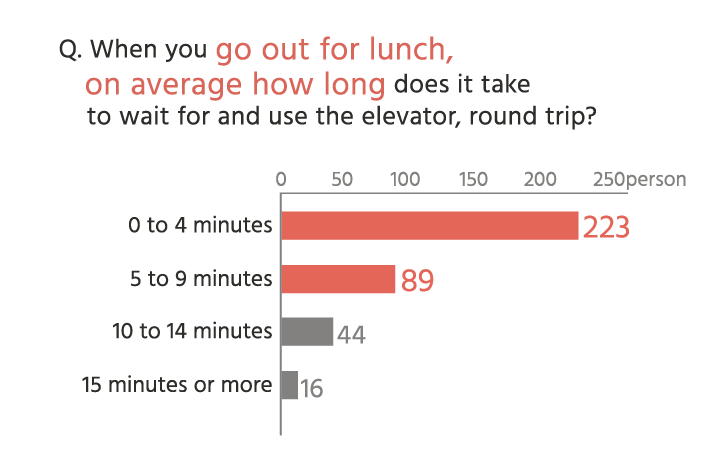
The majority of respondents reported the average time spent at lunchtime waiting for and taking the elevator, round trip, is 0 to 4 minutes. Although waiting time is somewhat mitigated in buildings with multiple elevators, it should also be noted that many people indicated times of 5 to 9 minutes. After all, the higher the floor, the greater the waiting time is likely to be.
Q.What kind of break time do people have for lunch during the day?

For the largest group of respondents (34%), the lunch break period is fixed, but they can also take lunch outside of that period. It is only slightly bigger than the next largest group (30%), who also have a fixed lunch break, but they can only take their lunch within that period. For the next group (20%), the lunch break period is not fixed, and they can decide their own lunch break to some extent. The respondents can be roughly divided into two groups: 34% who can only eat during a fixed time period, and 62% who are free to decide their own lunch breaks to some extent. It seems the degree of freedom is high. However, most respondents (46%), can only take 45 to 59 minutes for lunch, while 19% can take 30 to 44 minutes, and 15% can take 15 to 29 minutes. Regardless of whether the timing of the lunch break is flexible or not, an hour for lunch seems to be the standard.
When you only have limited time for lunch, the availability of eating places and convenience stores near the office becomes important. When asked about the situation for eating places and convenience stores near their offices, a substantial 68% indicated that there is an eating place within a five minute walk. The same high proportion (68%), responded that there is an employee cafeteria, eating place, or convenience store within their building (employee cafeteria 19%, eating place 22%, and convenience store 27%).
Because there are ample eating places and convenience stores in the neighborhood, many respondents go out to eat lunch, or go out to purchase lunch at a convenience store or food truck. These two groups account for 48% and 44%, respectively. However, there is a certain group of people who do not go out at all. This includes 25% who bring a lunch box, etc., from home, and 9% who buy their lunch on the way to work. That is more than the 9% who eat lunch in the employee cafeteria or a restaurant in the building.
Q.Which of the following most closely resembles your typical workday lunch?
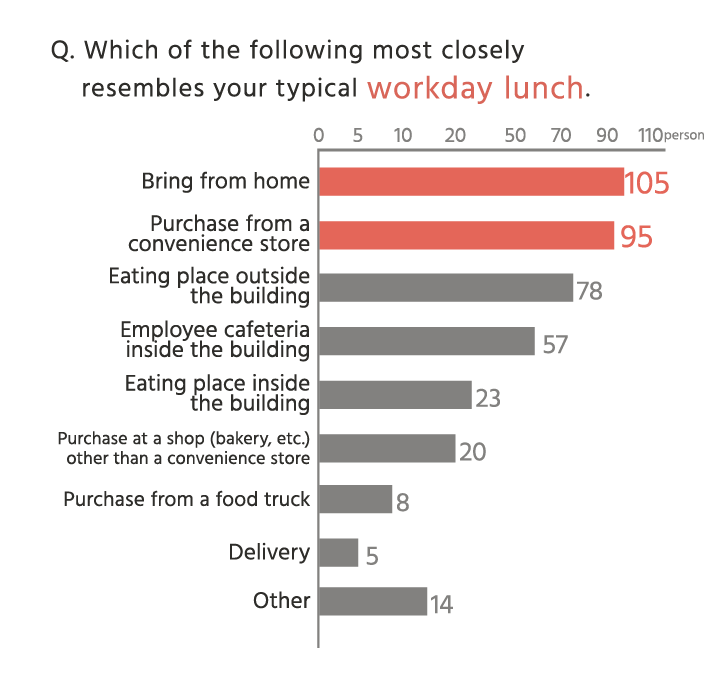
When asked about their typical lunch, most (26%) responded that they bring lunch from home, while 24% buy lunch at a convenience store, 19% eat at a restaurant outside the building, and 14% eat in the company cafeteria. Among those who buy lunch in a convenience store, a shop other than a convenience store (bakery, etc.), or from a food truck, the most frequently purchased items are rice balls (60%). This is followed by lunch boxes (bento) (57%), bread and pastries (53%), and sandwiches (46%). It seems most people choose something they can finish quickly and easily.
Actual lunch situation reveals surprising factors that cause people to become lunch refugees
Now we turn our focus to how people become lunch refugees. According to the questionnaire survey, half of the people indicated that they sometimes found themselves in a situation where they could not obtain lunch or they could not obtain what they had wanted to eat.
Q.Have you ever found yourself in a situation where you could not eat lunch, or could not eat what you had wanted to eat for lunch?
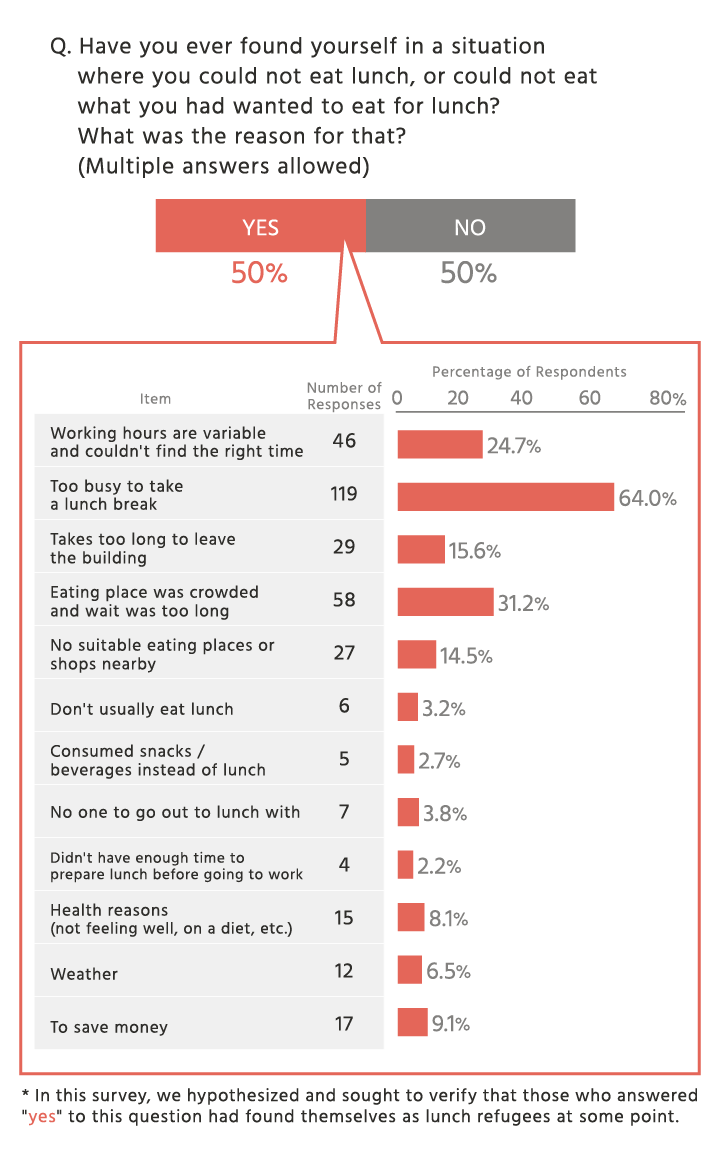
The most common reason given was that the person was busy and could not spare time for lunch. The next most common reasons, in order, were: long waiting time at an eating place due to the number of customers, working hours are irregular and couldn't squeeze in time for lunch, and it takes too much time to leave the building. In fact, looking at those who indicated that they were not able to eat lunch today or they were not able to eat what they had wanted today, by re-calculating the percentages of people who selected these responses compared to the overall responses, three main features emerged.
* In this survey, we hypothesized and sought to verify that those who answered "yes" to this question had become lunch refugees. In the following graphs, we assume that those who answered "yes" have found themselves as lunch refugees and those who answered "no" have never found themselves in that situation.
CASE 1: People working in an office on the 11th floor or higher, or in an office area within a commercial complex
Considering that the person needs to get and eat lunch within a limited lunch break, taking the time to go out will likely be a big inconvenience. The higher the floor on which the person works, the more likely the problem is to occur.
Q.On what floor do you work?
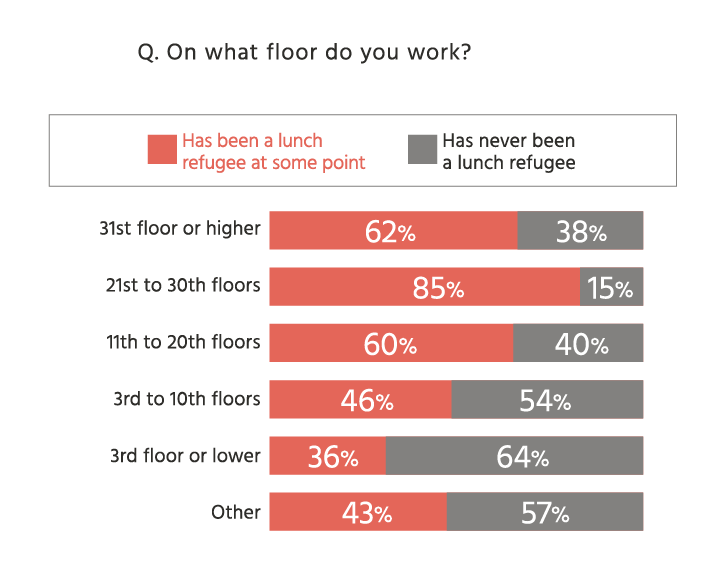
CASE 2: People whose lunch time is not fixed and who can decide themselves when to take lunch
At first glance, one might assume that when a person's lunch break is at a fixed time, they need to find something to eat during a crowded period, and they will be more likely to run out of time and become a lunch refugee. In reality however, the more freedom someone has in scheduling their lunch break, or the more difficult it is to find the right time, the more likely it is for someone to become a lunch refugee. Further verification of this point appears to be necessary.
Q. What kind of break time do you have for lunch during the day?
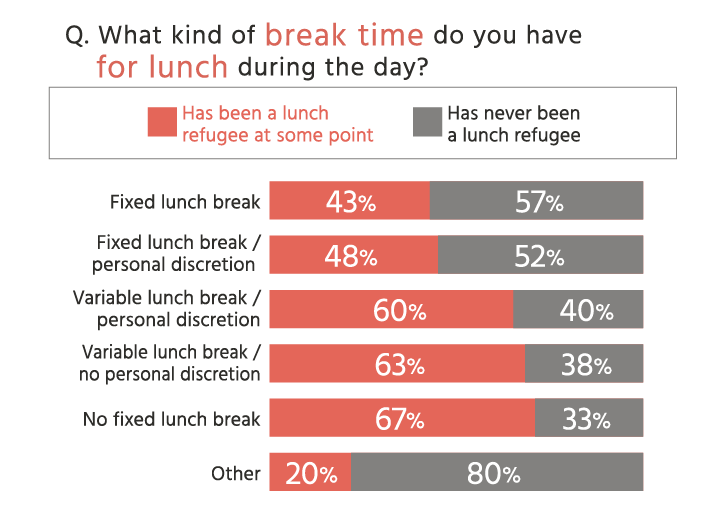
CASE 3: People who usually purchase lunch from food trucks or shops other than convenience stores
People who usually purchase lunch from food trucks or shops other than convenience stores are also highly likely to become lunch refugees.
Q. Which of the following most closely resembles your typical workdaylunch?

Since there are usually eating places, convenience stores, or other shops in office buildings or nearby, and food trucks are also available, finding lunch every day wouldn't seem to be a problem. However, these facilities do not seem to be a true solution for the lunch refugee problem. Even when a food place is nearby, if the waiting time is long due to crowding, the person may end up with nothing to eat.
Q. Please select the option(s) below that describe(s) the situation for eating places and convenience stores, etc., around your office. (Multiple answers allowed)
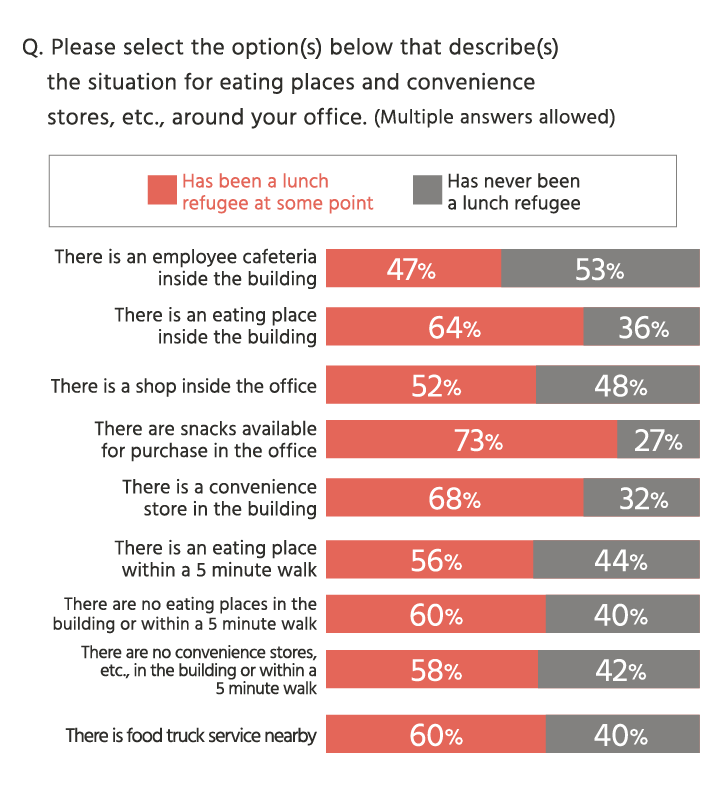
Dissatisfaction among office workers concerning their daily lunch situation
Finally, we asked working people for any complaints they may have about their lunch situations. About 53% of respondents said they were dissatisfied with their workday lunches. There were three main reasons given, each with almost the same percentage: crowded shops and convenience stores, lack of options, and their lunch break period and format. Other complaints and concerns related to prices and nutrition.
Q. Indicate any point of dissatisfaction you might hav ewith your workday lunches.
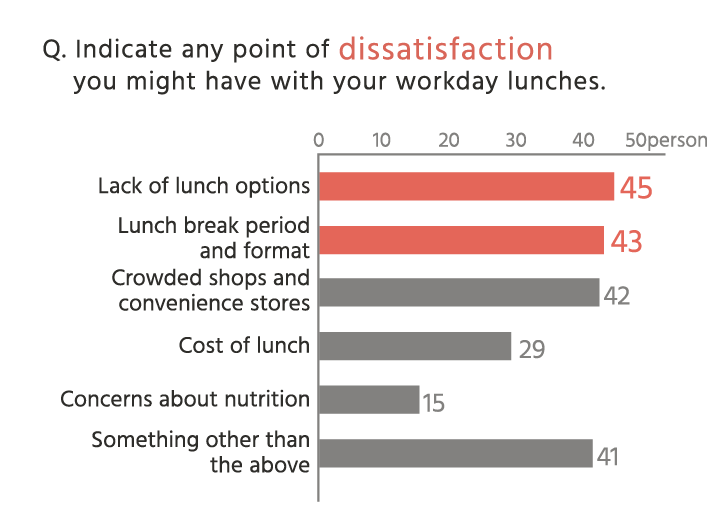
Regarding crowded shops and convenience stores, respondents indicated that the shops and convenience stores are crowded, waiting times are long, and they want more time to relax, and so on. Regarding lack of options, responses included: "There are few eateries nearby and I'm falling into a rut," "If you want something affordable, you have to eat the same thing all the time," "I never find anything new because I usually end up going to the same places," and "I am bored with the same menus all the time."
Comments about the survey results by a registered dietician from AIVICK
"It is concerning that buying lunch in a convenience store is in second place after bringing a lunch box from home. Eating meals from convenience stores may result in consumption of too many additives. For example, processed meat products generally contain a lot of phosphates, and are commonly found in convenience store meals. Furthermore, it is difficult to achieve balanced nutrition with these foods. If someone's lunch comes entirely from a convenience store, it may lead to a lack of certain nutrients over the entire day. The fact that people tend to buy the same convenience store foods every time also presents a problem for daily nutrition."
Customers can pay for totteMEAL easily through the app. It could help solve the problem of people being forced to skip lunch due to lineups at the cash register. Also, although the degree of dissatisfaction is low in this survey, as indicated by the dietician from AIVICK, a lack of lunch choices tends to result in poor nutritional balance. Since eating a delicious lunch can help people work harder, totteMEAL could contribute by helping workers eat a well-balanced and healthy diet. The results seem to support this idea. In addition, this survey uncovered a problem of hidden lunch refugees, besides the problems of crowded stores and time restrictions. What is the ideal solution for lunch refugees? We will further our investigation.
Special thanks to AIVICK Co., Ltd. https://www.aivick.co.jp/solution.html
To promote the health of workers using food, AIVICK is developing business areas to support the health of society through food and information and communication technologies. It has been collaborating with Game Changer Catapult since totteMEAL was first exhibited at South by Southwest 2017.



